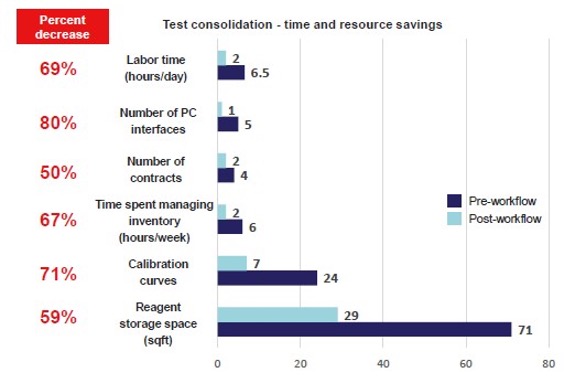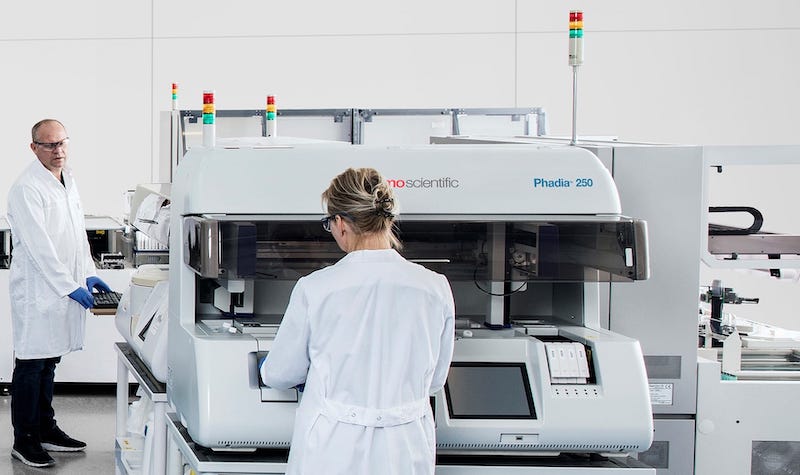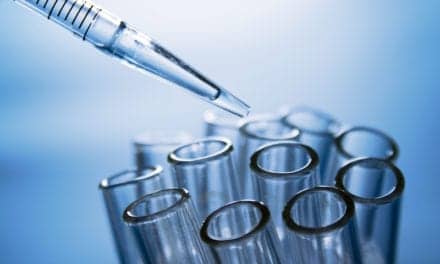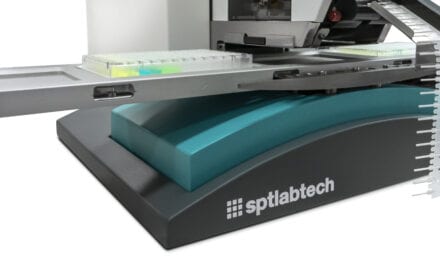Workflow analysis, supported by a partner, is key to helping labs identify strategies and implement changes that boost their efficiency, allowing them to continue delivering high-quality services.
By Jessica Murphy, MLS(ASCP)CM
Laboratories face significant challenges in today’s healthcare environment. Not only are they experiencing unprecedented demand for testing services, but there is simultaneously a shortage of medical technologists across the U.S.[i] These two issues combined means that existing personnel are overstretched trying to meet increasing demand, which further exacerbates the shortage as they seek new roles that offer higher job satisfaction. It is therefore imperative that these labs find ways to achieve more with fewer resources.
To meet growing demand for quality services, labs optimize their workflow to increase throughput, without sacrificing their high standards. However, labs may not have the right set-up and procedures to maximize productivity and efficiency. For example, use of numerous methodologies, require multiple instruments that use up valuable time and space. Further compounding the problem is that few labs have the resources to focus on optimizing their layout, meaning there is little-to-no room for additional instrumentation—limiting their ability to meet increasing demand.
To overcome these barriers and improve productivity, labs can undergo workflow analysis in collaboration with a trusted partner. Workflow analysis allows them to both find and solve workflow inefficiencies, subsequently maximizing productivity and improving the quality of their services.
What Is Workflow Analysis?
During workflow analysis, labs and vendors collaborate to identify areas for optimization. Optimizing workflows offer labs several benefits:
- More efficient, faster, and cost-effective processes
- Better resource utilization
- Improved quality of diagnostic testing results
- Boosted staff morale/work engagement
- Minimized repetitive, manual tasks
So, what approaches can labs take to optimize their workflow? Three key strategies can help them make significant improvements: reducing manual work, consolidating methodologies, and better space utilization.
#1 Reduce manual work
One of the biggest sources of inefficiency in labs is manual processes. However, owing to recent instrument advances, many areas of the workflow can now be automated for improved efficiency, fewer errors, and greater scalability. To introduce automation, labs need to identify processes that they perform manually and determine which of these can be replaced by available automation tools.
When determining which areas of the workflow are the most appropriate to automate, multiple aspects need to be considered:
- Lab requirements: Determine how many assays can be automated with one system to maximize value—some labs may find a single automated platform can encompass their full test menu. Evaluate the solutions based on individual needs, such as throughput and scalability.
- Overall costs: Evaluate both the immediate expenditure (upfront costs) and the return on investment (ROI) of any proposed solution to understand the true value.
- Quality of results: Make sure that any automated solution considered delivers high-quality results as well as efficiency gains.
- Vendor: Choose a trustworthy vendor that understands and supports the lab’s wider optimization goals.
#2 Consolidate methodologies
Many labs suffer from unnecessarily complex workflows, consisting of multiple methodologies. Consolidating these can bring significant efficiency gains. For example, labs traditionally perform testing to support allergy and autoimmune diagnosis on different platforms—yet these can now be done on a single, automated platform.
To simplify the workflow, examine the lab’s existing instrumentation and check its capabilities, to see if any methodologies can be consolidated. Depending on current capabilities and lab needs, other appropriate instrumentation for testing consolidation may need to be implemented.
#3 Make the most of existing space
An unexpected source of inefficiency in the lab is space utilization. Lab space is expensive, so it is vital to use existing facilities as effectively as possible to avoid any unnecessary expenditure. Unfortunately, labs can have ineffective set-ups, making it difficult to add new instrumentation into their existing space to increase their throughput.
Labs can optimize their space, however. To do so, first examine the existing layout, and identify any high-traffic areas and high-use instruments—equipment needs to be carefully positioned to reduce time spent walking. Additionally, it may be possible to decommission some instruments, through consolidation, as discussed above, to free up floor space.
While the above strategies can significantly streamline workflows, there are many other ways to boost workflow efficiency, which can be determined by working with a workflow analysis and optimization partner. A lab in Geisinger Medical Center sought such services, with staggeringly positive results.
Further Reading
Optimization Case Study: the Geisinger Lab
Geisinger, a 550-bed hospital in Danville, Pennsylvania, has a core clinical lab that serves as a reference for facilities performing autoimmune and allergy testing. Each year, the lab processes approximately 80,000 allergy tests and 55,000 autoimmune tests. Geisinger wanted to improve their efficiency, and so looked to optimize its workflow.
Working with the support of Thermo Fisher Scientific, Geisinger undertook a workflow analysis. Initially, their lab used seven separate platforms for autoimmune and allergy testing, which not only made the workflow complex, but also required 638 square feet to operate. Based on this evaluation, Geisinger leadership discovered they could significantly optimize their workflow through instrument and methodology consolidation, which involved replacing their existing instrumentation with a single platform.
Improving efficiency through testing consolidation
By consolidating their testing, Geisinger lowered the number of methodologies used from four to two. With fewer methodologies needed, Geisinger was able to reduce its platforms from seven to three—two Thermo Fisher Scientific Phadia 250 systems and a manual bench method remaining. Reducing the number of instruments meant that there was less maintenance, fewer process steps, and fewer screens to monitor. Consequently, owing to the reduced workload, one staff member was freed up for other tasks.
To fully understand the benefits of consolidation, Geisinger quantified advantages in several key areas:
Manual labor time
The total hands-on time of lab staff to prepare, operate, and manage the testing process exclude pre-analytical activities but include result reporting. Bringing in automated platforms reduced daily manual testing time from 4.2 hours to 2.5 hours, representing a 38% improvement.
Total cumulative testing time
The total cumulative testing time to process samples from the start of testing until the result reporting is completed. This includes both manual and automated times. In total, the cumulative testing time dropped from 17.7 hours to 15.3 hours, demonstrating a 14% improvement.
Space utilization
Functional space allocated for allergy and autoimmune testing. This includes instrument footprint, system clearances, bench space, travel paths, refrigeration, and ambient storage. By reducing the amount of instrumentation used, and rearranging it into a more logical layout, Geisinger increased its free lab space by 57%.
Labor value
There is an economic impact whenever manual labor and space allocation changes. This can be found by quantifying both metrics, multiplying them by an acceptable cost figure. Overall labor costs for operating allergy and autoimmune testing at the lab was reduced by almost $20,000 per year.
Room to grow: Maximizing productivity
After Geisinger optimized its workflow, the lab experienced increased demand for its services. Owing to its more streamlined set-up and workflow, Geisinger was perfectly positioned to expand its service to meet the increased demand. To do so, the lab brought in an additional, larger automated instrument: a Phadia 1000.
Following the implementation of the Phadia 1000 instrument, and 13 months after the initial workflow analysis, Geisinger determined the effects of optimization and found significant productivity enhancements:
- Time and resource savings: Several key metrics decreased by ≥50%, including labor time, weekly inventory management hours, and reagent storage space (Figure 1).
- Higher throughput: The lab increased testing by 77% overall.
- Increased free lab space: A total of 90 sq ft of lab space was freed up (42%) compared to the original workflow analysis, which was estimated to be worth $35,700 of space savings annually.
- Reduced time spent walking: Optimization significantly reduced technician walk-around time for daily operations, as shown in the two spaghetti diagrams (Figure 2).



Unlock the Lab’s Full Potential with a Workflow Analysis
Improving workflow efficiency is critical to effectively meet growing demand for services—particularly in light of medical technologist shortages. Workflow analysis, supported by a partner, is key to helping labs identify strategies and implement changes that boost their efficiency, allowing them to continue delivering high-quality services.
The Geisinger study clearly demonstrates the benefits of workflow optimization. Through workflow analysis performed in partnership with a vendor, they determined consolidation was a viable strategy to make their allergy and autoimmune testing processes more efficient. After implementing the recommended changes, they significantly reduced manual labor time, cumulative testing time and lab space, and could easily grow its services to meet increasing demand. With fewer distractions and delays caused by inefficiencies, the Geisinger lab is now able to focus on what is most important—offering high quality results with improved turn around time to clinicians and inevitably improving patient care.
ABOUT THE AUTHOR

Jessica Murphy, MLS(ASCP)CM, has been an ASCP certified Medical Technologist for 12+ years. Before joining Thermo Fisher Scientific she spent time in specialized and clinical laboratories. She is skilled in allergy and autoimmune disease testing and platforms.
REFERENCE
[i] Stone J. We’re facing a critical shortage of medical laboratory professionals. Forbes. November 8, 2022. Accessed October 16, 2023. https://www.forbes.com/sites/judystone/2022/04/28/were-facing-a-critical-shortage-of-medical-laboratory-professionals/.





